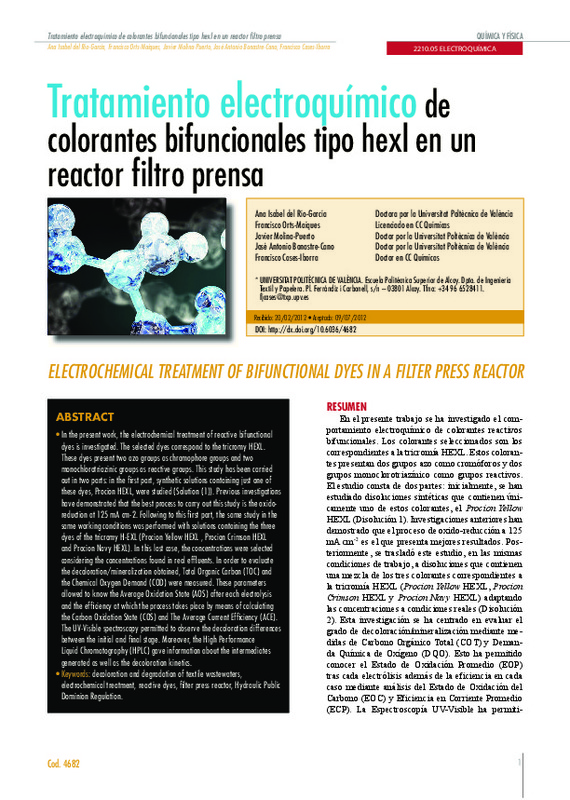|
Resumen:
|
[EN] In the present work, the electrochemical treatment of reactive bifunctional dyes is investigated. The selected dyes correspond to the tricromy HEXL. These dyes present two azo groups as chromophore groups and two ...[+]
[EN] In the present work, the electrochemical treatment of reactive bifunctional dyes is investigated. The selected dyes correspond to the tricromy HEXL. These dyes present two azo groups as chromophore groups and two monochlorotriazinic groups as reactive groups. This study has been carried out in two parts: in the fi rst part, synthetic solutions containing just one of these dyes, Procion HEXL, were studied (Solution (1)). Previous investigations have demonstrated that the best process to carry out this study is the oxidoreduction at 125 mA cm-2. Following to this fi rst part, the same study in the same working conditions was performed with solutions containing the three dyes of the tricromy H-EXL (Procion Yellow HEXL, Procion Crimson HEXL and Procion Navy HEXL). In this last case, the concentrations were selected considering the concentrations found in real effluents. In order to evaluate the decoloration/mineralization obtained, Total Organic Carbon (TOC) and the Chemical Oxygen Demand (COD) were measured. These parameters allowed to know the Average Oxidation State (AOS) after each electrolysis and the effi ciency at which the process takes place by means of calculating the Carbon Oxidation State (COS) and The Average Current Effi ciency (ACE). The UV-Visible spectroscopy permitted to observe the decoloration differences between the initial and fi nal stage. Moreover, the High Performance Liquid Chromatography (HPLC) gave information about the intermediates generated as well as the decoloration kinetics.
[-]
[ES] En el presente trabajo se ha investigado el comportamiento electroquímico de colorantes reactivos bifuncionales. Los colorantes seleccionados son los correspondientes a la tricromía HEXL. Estos colorantes presentan ...[+]
[ES] En el presente trabajo se ha investigado el comportamiento electroquímico de colorantes reactivos bifuncionales. Los colorantes seleccionados son los correspondientes a la tricromía HEXL. Estos colorantes presentan dos grupos azo como cromóforos y dos grupos monoclorotriazínico como grupos reactivos. El estudio consta de dos partes: inicialmente, se han estudiado disoluciones sintéticas que contienen únicamente uno de estos colorantes, el Procion Yellow HEXL (Disolución 1). Investigaciones anteriores han demostrado que el proceso de oxido-reducción a 125 mA cm-2 es el que presenta mejores resultados. Posteriormente, se trasladó este estudio, en las mismas condiciones de trabajo, a disoluciones que contienen una mezcla de los tres colorantes correspondientes a la tricromía HEXL (Procion Yellow HEXL , Procion Crimson HEXL y Procion Navy HEXL) adaptando las concentraciones a condiciones reales (Disolución 2). Esta investigación se ha centrado en evaluar el grado de decoloración/mineralización mediante medidas de Carbono Orgánico Total (COT) y Demanda Química de Oxígeno (DQO). Esto ha permitido conocer el Estado de Oxidación Promedio (EOP) tras cada electrólisis además de la eficiencia en cada caso mediante análisis del Estado de Oxidación del Carbono (EOC) y Eficiencia en Corriente Promedio (ECP). La Espectroscopía UV-Visible ha permitido observar las diferencias de decoloración entre el estado inicial y final en todos los casos. Además, la Cromatografía Líquida de Alta Resolución (HPLC) ha permitido conocer la evolución de los intermedios generados así como la cinética de decoloración.
[-]
|









